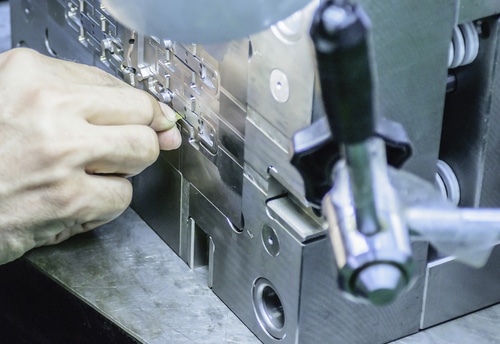
Sheet metal tools are used in a wide variety of manufacturing areas, from construction to automotive. And when it comes to building these parts, prototype and production tooling plays a critical role, but there’s no one-size-fits-all solution. Manufacturers can choose to make custom prototype tools via soft tooling or hard tooling, depending on the size and scope of their project.
By choosing the right approach for your sheet metal tooling process, you can ensure a higher quality product, while also staying on schedule and on budget. So how do you know when to embrace soft tooling vs hard tooling? The first step is understanding the specific differences between the two, as well as the most common use cases for each.
In this article, we provide a general overview of the sheet metal tooling process, definitions for applicable manufacturing terms, and of course, how to make the decision between soft tooling and hard tooling. Keep reading to learn more.
Tooling vs tools
Before we get into soft tooling and hard tooling, let’s make sure we fully understand the term “tooling.” Tools, as we all know, are items used to achieve a particular objective. Tooling, also known as machine tooling, is the process of designing and developing those tools, so that they can be used to manufacture necessary parts and components.
When sheet metal tooling is not executed correctly, the tools do not work as intended, leading to complications in the production process, and ultimately flaws in the end product. This is why, for die and mold manufacturers in particular, the tooling process is so important, and the debate between soft tooling and hard tooling remains relevant.
Soft tooling
Soft tooling is known for its speed, flexibility, and cost-effectiveness. It’s a popular choice among manufacturers looking to produce a low volume of parts, typically 1 to 100 units, without investing significant time and resources. Various materials can be leveraged when using this method, with silicone being the most popular example.
Soft tooling for sheet metal works great for prototyping, since it allows manufacturers to see how tools will look and function in their final stage. However, since these tools are made up of soft materials like silicone, they are not very durable, and are therefore not the best option for long and heavy production runs. Eventually, the tools will wear down and need to be replaced.
Hard tooling
Unlike soft tools, hard tools can go through multiple production cycles without wearing down. They are made up of durable materials like steel and aluminum, making them a reliable option for projects that require high production speed and precision. Manufacturers prefer hard tooling when they need to produce a high volume of parts, typically 100 to 100,000 or more units. Hard tools are built using an injection mold machine, which inserts material into a mold where it then solidifies, thus forming the tool. This process may also involve extra machining, heat treatments, and post processing to attain a smooth finish.
Hard tooling is usually more expensive and time consuming than soft tooling, as it requires higher upfront costs and more lead time for manufacturers. But if the project calls for a large number of highly-durable tools, then it’s likely your best option.
When to use sheet metal soft tooling vs hard tooling
Some of the most common use cases for soft tooling include executing jobs with quick turnaround times, creating prototypes for stakeholders, and market testing. When producing a few thousand parts or less, working with soft tools is ideal, since you won’t need them for an extended period of time anyway. For on-demand, low-quantity projects, soft tooling allows you to save money and get the job done faster.
Let’s say your business’ stakeholders, or other VIPs, are requesting a behind-the-scenes look into your operation. Rather than creating hard tools for them to look at, you can use your budget more wisely by showing them the soft tool version. Then, when it’s time to actually build the tools for production, you can switch to a hard tooling approach.
You can also avoid spending unnecessary time and money by relying on soft tooling for market tests. Creating prototypes and presenting them to employees, industry experts, and other relevant parties allows you to get feedback on the parts before entering full swing production. If you build your hard tools too quickly, you may run into serious problems down the line, leading to higher-than-expected production costs and missed product deadlines.
Simply put, you should try to go with soft tooling whenever possible, as it will save you significant time, money, and effort in the long run. However, it’s important to know which jobs require hard tooling, so that you’re not making any sacrifices when it comes to operational efficiency and overall product quality. For products that require tools with highly-precise blueprints, hard tooling may be your only option.
What’s your budget and timeline? How many parts are you producing? How durable do the tools need to be? What is the exact process for manufacturing each part? Would this process be more efficient with hard tools? Answering these questions can be difficult, especially with limited knowledge and experience in the tooling space. Luckily, you don’t have to make the decision alone.
Team up with production and prototype tooling experts
For many projects, it’s best to partner with an engineering team that has a deep understanding of soft tooling and hard tooling, as well as years of experience launching successful products. And that’s where RCO Engineering comes in. We work with businesses all across the aerospace, automotive, and defense industries, building tools for compression molds, vacuum forming, metal stamping, and more. We’d love to learn all about your business and its upcoming projects, so we can help launch your next successful product. Get in touch with us today!

Comments